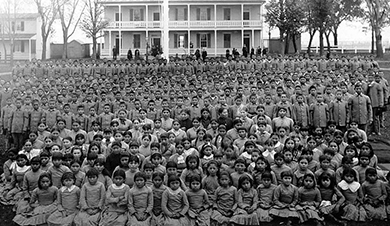| << Chapter < Page | Chapter >> Page > |

A vital part of the assimilation effort was land reform. During earlier negotiations, the government had respected that the Indian tribes used their land communally. Most Indian belief structures did not allow for the concept of individual land ownership; rather, land was available for all to use, and required responsibility from all to protect it. As a part of their plan to Americanize the tribes, reformers sought legislation to replace this concept with the popular Euro-American notion of real estate ownership and self-reliance. One such law was the Dawes Severalty Act of 1887, named after a reformer and senator from Massachusetts, which struck a deadly blow to the Indian way of life. In what was essentially an Indian version of the original Homestead Act, the Dawes Act permitted the federal government to divide the lands of any tribe and grant 160 acres of farmland or 320 acres of grazing land to each head of family, with lesser amounts to others. In a nod towards the paternal relationship with which whites viewed Indians—similar to the justification of the previous treatment of African American slaves—the Dawes Act permitted the federal government to hold an individual Indian’s newly acquired land in trust for twenty-five years. Only then would he obtain full title and be granted the citizenship rights that land ownership entailed. It would not be until 1924 that formal citizenship was granted to all Native Americans. Under the Dawes Act, Indians were given the most arid, useless land. Further, inefficiencies and corruption in the government meant that much of the land due to be allotted to Indians was simply deemed “surplus” and claimed by settlers. Once all allotments were determined, the remaining tribal lands—as much as eighty million acres—were sold to white American settlers.
The final element of “Americanization” was the symbolic “last arrow” pageant, which often coincided with the formal redistribution of tribal lands under the Dawes Act. At these events, Indians were forced to assemble in their tribal garb, carrying a bow and arrow. They would then symbolically fire their “last arrow” into the air, enter a tent where they would strip away their Indian clothing, dress in a white farmer’s coveralls, and emerge to take a plow and an American flag to show that they had converted to a new way of life. It was a seismic shift for the Indians, and one that left them bereft of their culture and history.
Take a look at the Carlisle Industrial Indian School where Indian students were “civilized” from 1879 to 1918. It is worth looking through the photographs and records of the school to see how this well-intended program obliterated Indian culture.
The interaction of the American Indians with white settlers during the western expansion movement was a painful and difficult one. For settlers raised on the notion of Manifest Destiny and empty lands, the Indians added a terrifying element to what was already a difficult and dangerous new world. For the Indians, the arrival of the settlers meant nothing less than the end of their way of life. Rather than cultural exchange, contact led to the virtual destruction of Indian life and culture. While violent acts broke out on both sides, the greatest atrocities were perpetrated by whites, who had superior weapons and often superior numbers, as well as the support of the U.S. government.
The death of the Indian way of life happened as much at the hands of well-intentioned reformers as those who wished to see the Indians exterminated. Individual land ownership, boarding schools, and pleas to renounce Indian gods and culture were all elements of the reformers’ efforts. With so much of their life stripped away, it was ever more difficult for the Indians to maintain their tribal integrity.

Notification Switch
Would you like to follow the 'U.s. history' conversation and receive update notifications?